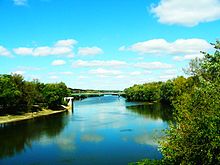Lafayette ( /ˌlɑːfiːˈɛt/ or lah-fee-YET) is a city in and the county seat of Tippecanoe County, Indiana, United States,[4] 63 miles (101 km) northwest of Indianapolis. West Lafayette, on the other side of the Wabash River, is home to Purdue University, which has a large impact on both communities. Together, Lafayette and West Lafayette form the core of the Lafayette, IN Metropolitan Statistical Area.
/ˌlɑːfiːˈɛt/ or lah-fee-YET) is a city in and the county seat of Tippecanoe County, Indiana, United States,[4] 63 miles (101 km) northwest of Indianapolis. West Lafayette, on the other side of the Wabash River, is home to Purdue University, which has a large impact on both communities. Together, Lafayette and West Lafayette form the core of the Lafayette, IN Metropolitan Statistical Area.
According to the 2010 census, its population was 67,140, an increase of 19% from 56,397 in 2000
The town of Lafayette was platted in May 1825 by a river trader William Digby. It was made county seat of the newly formed Tippecanoe County the following year. Like many frontier towns, Lafayette was named for General Lafayette, a French soldier who significantly aided George Washington's Continental Army during the American Revolutionary War. Lafayette toured the United States in 1824 and 1825
In its earliest days, Lafayette was a shipping center on the Wabash River. In 1838, Henry Leavitt Ellsworth, the first United States Patent Commissioner, published a booklet titled Valley of the Upper Wabash, Indiana, with Hints on Its Agricultural Advantages to promote settlement of the region. By 1845, Ellsworth had purchased 93,000 acres (380 km2) of farmland in and around Lafayette and moved there from Connecticut to supervise land sales.[7] By 1847 Ellsworth was distributing broadsides looking for farmers to purchase his farmland.[8] He became president of the Tippecanoe County Agricultural Society in April 1851 – despite some local resentment over what was called "the Yale Crowd" – but he was defeated the same year when he ran for the Indiana House of Representatives.[9] Lafayette's Ellsworth Street and Ellsworth Historic District are named for the early real estate developer.[10]
The Wabash and Erie Canal in the 1840s further cemented Lafayette's regional prominence, which was also heightened by the arrival of therailroads in the 1850s. The Monon Railroad connected Lafayette with other sections of Indiana.
Lafayette was the site of the first official air mail delivery in the United States, which took place on August 17, 1859, when John Wise piloted a balloon starting on the Lafayette courthouse grounds. Wise hoped to reach New York; however, weather conditions forced the balloon down nearCrawfordsville, Indiana, and the mail reached its final destination by train. In 1959, the U.S. Postal Service issued a 7¢ airmail stampcommemorating the centennial of the event.
Colleges
[edit]Public
K-12 public education in Lafayette is provided by the Lafayette School Corporation. The Tippecanoe School Corporation also administers county schools nearby. New Community School is a tuition-free elementary charter school (sponsored by Ball State University) located in downtown Lafayette.



No comments:
Post a Comment